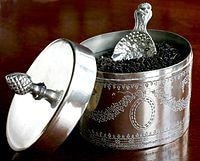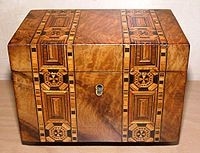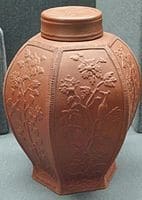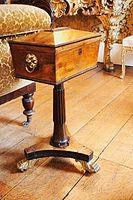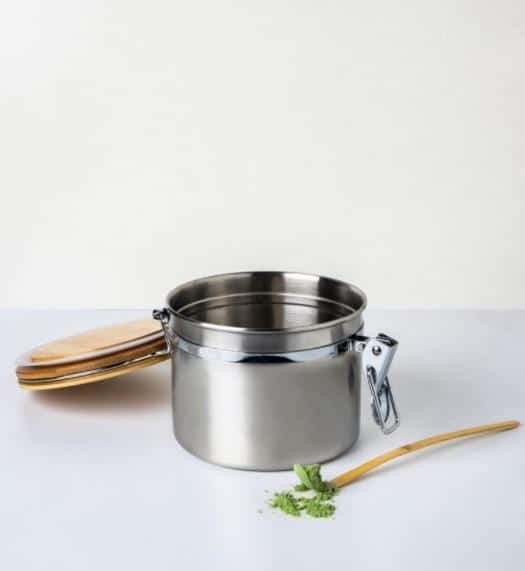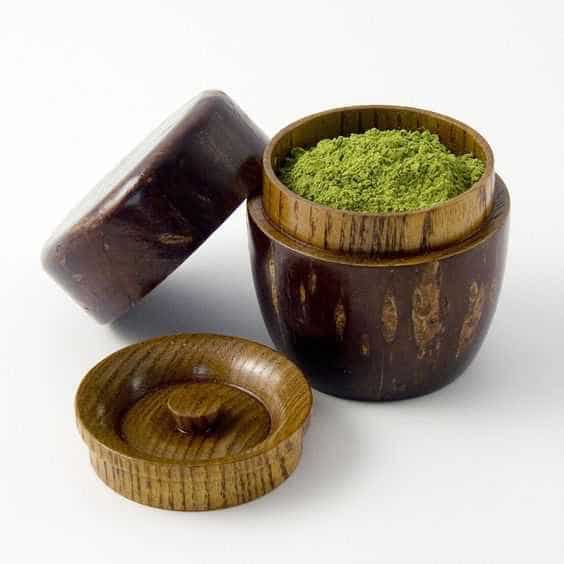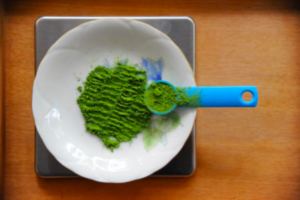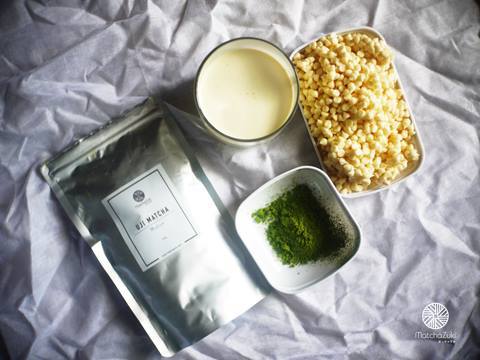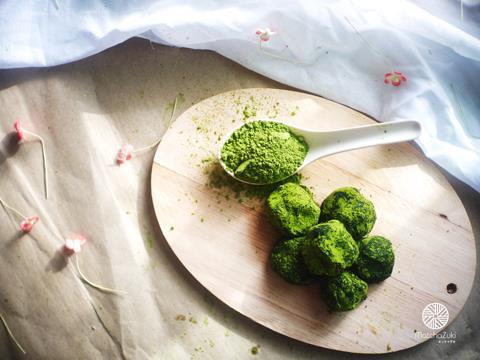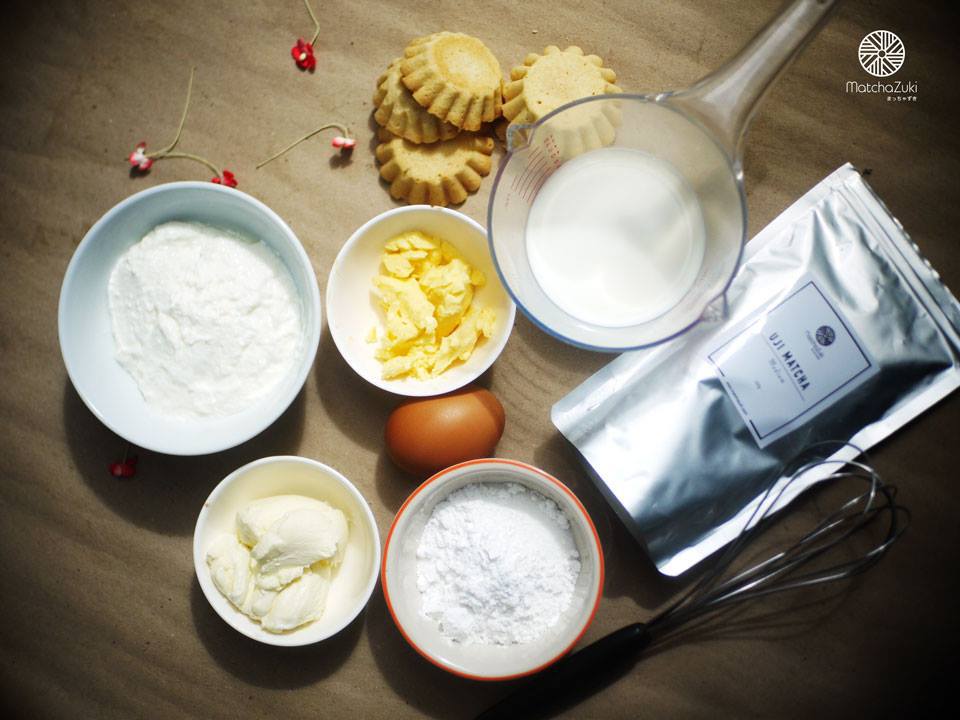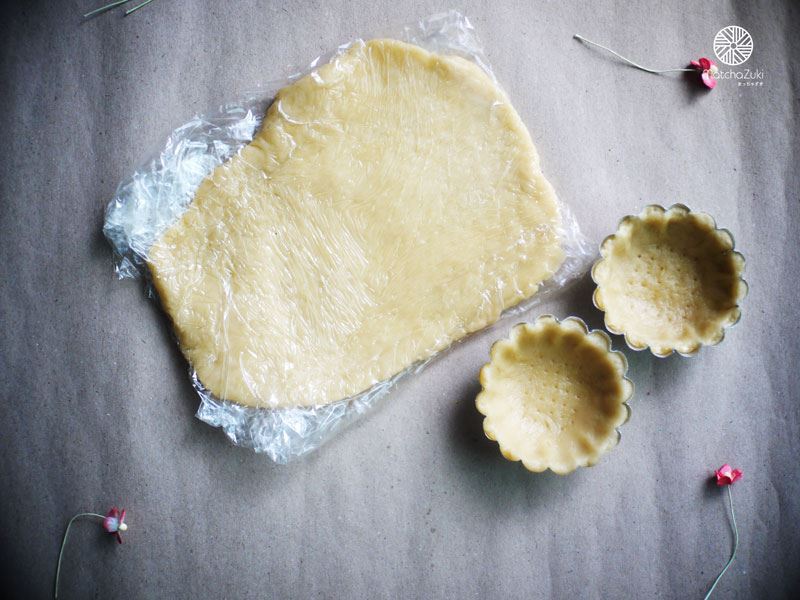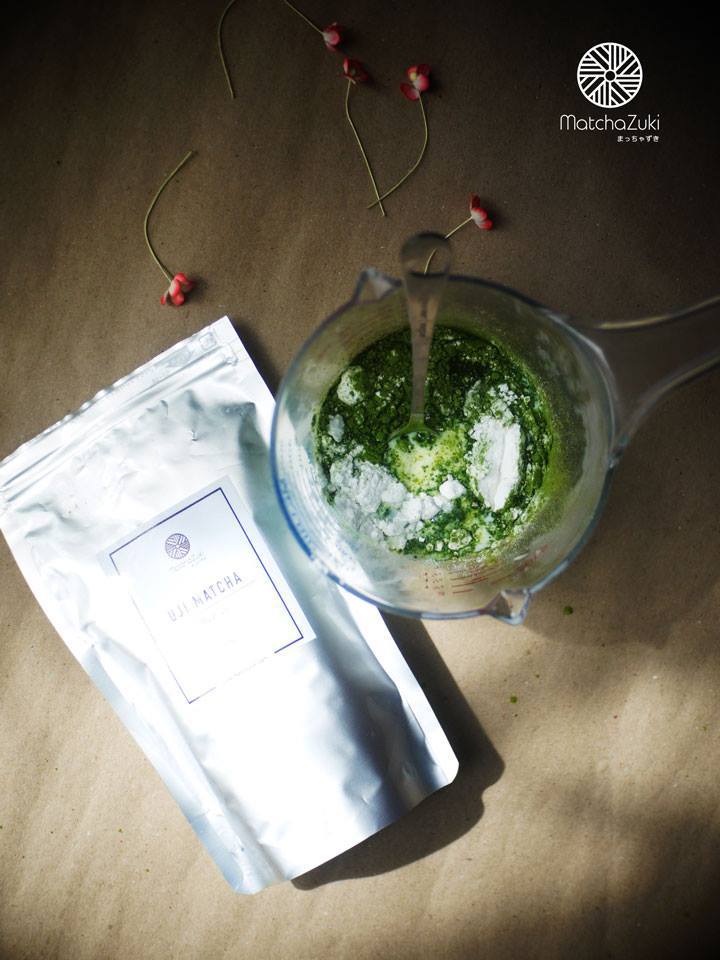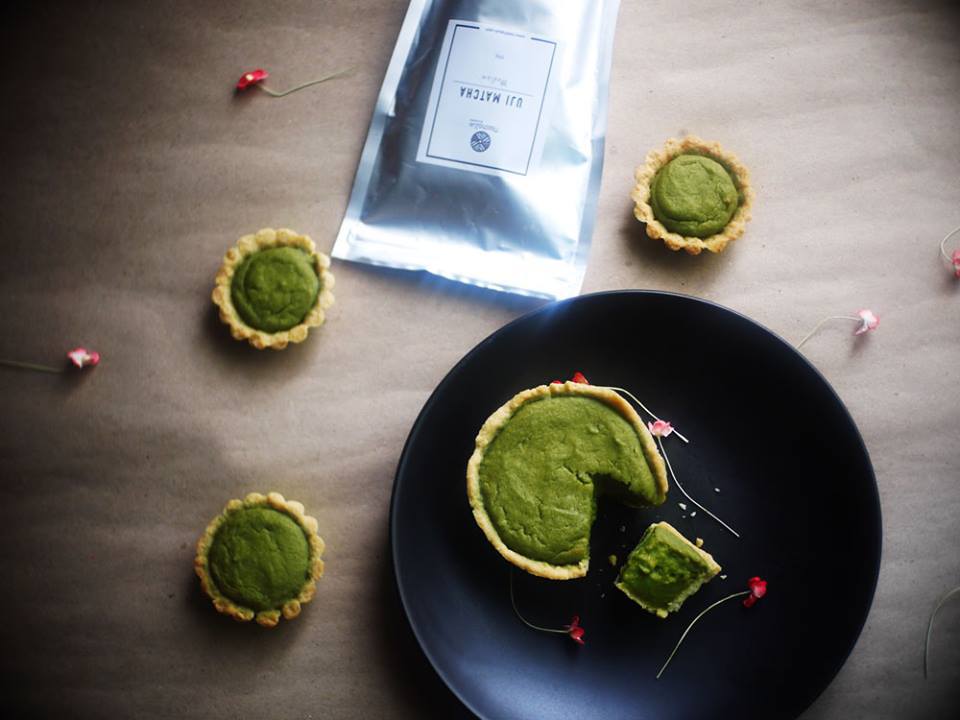Tag: ผงชาเขียว
Iced Matcha Latte Iced Matcha Latte
Turn your cold green tea into a premium matcha latte, a popular menu item of the shop that is so delicious you have to tell others!!
Good quality matcha powder will give a beautiful green color. When poured over fresh milk, you will see a layer of emerald green gradually seeping down. The method of making it is not difficult. Especially if you have the equipment to help, it will not take long to brew. Let’s see the ingredients and brewing method. ^^
Dissolving aid
- Matcha powder sieve
- Chasen (茶筅) is a bamboo stick used to grind green tea powder to prevent it from clumping.
- Portable milk frother (Mini milk mixture)
- Shaker cylinder
Ingredients for a 16 Oz. glass.
- MATCHAZUKI Excellent Grade Matcha Powder 3 grams (~1.5 teaspoons)
- Warm water 40 ml
- Fresh milk 150 ml
- 10 ml syrup (~2 teaspoons)
- ice
Brewing process
1. Dissolve matcha powder in warm water by sifting matcha powder through a sieve into a cup or bowl, then pour in warm water and use a Chasen or milk frother to beat the tea powder into the water. Then set aside.
2. Add ice to another glass.
3. Add syrup according to desired sweetness.
4. Pour in fresh milk and mix with syrup.
5. Pour the dissolved matcha over the fresh milk.
Or you can watch a video on how to make it here ^^
*** If you don’t have a dissolving device, try this method.
———————————-
Learn more about tea storage boxes
Most green tea lovers already know that tea powder should not only be stored in a tightly closed, opaque, and airtight container, but also be kept away from sunlight or heat for long periods of time, and should be stored in a cool place. However, after taking it out of the refrigerator, it should be left for a while to cool before opening the container to prevent the tea from becoming damp.
Since tea powder is sensitive to light and has a delicate storage method, the tea storage box should be as precise as possible to preserve the quality of the tea and protect the tea powder from the air. Therefore, glass bottles and transparent bottles are not suitable for storing tea powder. This tea powder storage box is called棗 or natsume (Tea caddy) in Japanese.
The origin of tea storage boxes comes from Europe because in the past, tea was very expensive. The culture of tea consumption among the British was spread from China in the mid-17th century. At that time, it was believed that tea could cure diseases and had many health benefits. Tea had been known in the East for thousands of years. The British therefore valued tea very much. Because tea at that time was expensive, it had to be stored with a lock and key very well. The boxes used to store tea powder were often expensive and decorated to match the atmosphere in the living room or other reception rooms where tea would be served. Tea storage boxes come in many materials, such as wood, with mahogany and rosewood being popular. There are also many different looks, both hexagonal and octagonal. There have been continuous developments, including boxes made of clay, stainless steel, in many shapes and designs. However, the most obvious characteristic is that all types of boxes are opaque. If anyone currently puts their tea in a clear plastic box, even if it has a tight-fitting lid, it would be better to change to a box with the correct shape.
Therefore, when choosing a tea storage box, you can choose either stainless steel or wood. Just make sure the lid is tight. If there is a lock to close it tightly, it will help extend the shelf life of the tea powder. If anyone is looking for a tea powder storage box, try choosing from htps://matchazuki.com/product/canister/
Source
https://matchazuki.com/product/canister/
Article from: Fuwafuwa
How to check if matcha powder is of good quality
With the popularity of matcha powder and green tea influenced by Japan, there are rapidly increasing sources of matcha powder and green tea leaves in Thailand, whether imported from Japan, China, or even produced in Thailand. The origin of each tea affects the different tastes and aromas. Another point to be careful about is not telling the true properties of the tea leaves. Every shop will say that it is original tea from Japan, so how can we know which shops have real green tea powder? You can observe these factors.
- The first thing to notice is color . The darker the matcha, the less bitter it will be. This is because it is a well-maintained matcha, a good variety, with a dark green color. It can be drunk directly as a thick brew (Koicha). It is recommended to use a lower grade of matcha powder used in baking because it will have a more intense flavor. When mixed with other ingredients, it will create a more intense flavor. Also, don’t forget to check the container or package that the tea is in. Good matcha powder has a shelf life of about 6 months and should be used up within 4 months after opening. If stored longer than that, the color will start to fade and the aroma will be less fragrant. This is because the tea leaves are steamed at high temperatures during the manufacturing process to stop the oxidation reaction. However, as time passes, the tea leaves are constantly exposed to oxygen, causing them to turn yellow, just like normal leaves that change from green to yellow.

2. Ingredients: Some matcha powders are actually cheap. This is partly due to the fact that the matcha powder is mixed with flour, not pure green tea. This is why they can be so cheap. Don’t forget to flip the package to read the ingredients clearly before buying the wrong one.
3. Reviews from other customers: Don’t forget to check out reviews from people who have already purchased and consumed the product to see what delicious dishes it can be made into and how much to use. This will provide ideas and encourage those who read the reviews to buy it and try it out.
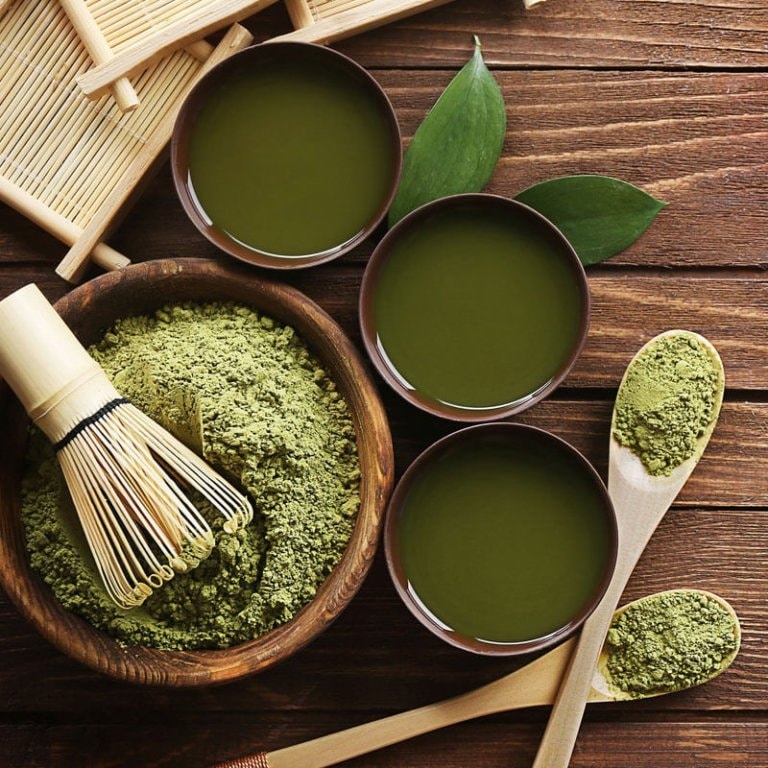
4. Source: Check the source clearly to see which city in Japan it comes from. For example, the most popular cities for green tea are Uji and Kyoto. However, Shizuoka is also equally famous. Knowing the source in detail will help us be more confident in the quality of the tea.
5. Price: Don’t forget to compare market prices to see if the tea you’re buying is too expensive or too cheap. Even if it’s a good quality tea imported from Japan, you should check prices from multiple sources. And don’t forget to check prices from Japan itself, because some products imported directly from the source are several times cheaper than those produced in Thailand. Green tea itself comes in many grades, and each grade has a different price. Checking the same grade will give you the clearest price range.
6. The seller’s name may not be a significant factor, but if you know the source, have a Line@ page, Facebook page, or a reliable website, this is another factor that will help build consumer confidence.
Just 6 simple things to be careful of and think about before buying to ensure you get good quality tea at a reasonable price.
Source
https://cookingchew.com/matcha.html
https://drericz.com/recipes/diy-super-greens-mix/
Article: Fuwafuwa
Speaking of matcha, why does it have to be Uji matcha?
In Japan, products lined up in supermarkets and sweets in sweet shops that use matcha as an ingredient are advertised everywhere as using Uji matcha. Recently, people in Thailand have probably become more familiar with the name “Uji”. Have you ever wondered why it has to be Uji matcha and not other kinds of matcha?
- Definition of Uji Matcha
“Uji” is the name of a city in Kyoto Prefecture. The roots of Japanese culture have been here for over a thousand years, as evidenced by the World Heritage Site Byodoin Temple, but it is also the source of tea production in Japan. In the 12th century during the Song Dynasty of China, when the monk Eisai first brought tea and a millstone from China to Japan, it was brought to Kyoto. It can be said that the first tea drunk in Japanese history was matcha. As China abandoned this ancient drinking method and adopted the current hot extraction method, extracting the tea leaves.
But in fact, Uji tea today is not only grown in Uji City.
The Kyoto Prefectural Tea Bureau defines Uji tea as tea grown in four prefectures that have developed, taking into account their history, culture, geography, and climate: Kyoto, Nara, Shiga, and Mie. Tea is processed by the Kyoto Prefectural Tea Bureau in Kyoto.
In addition, the Uji Matcha registration defines matcha as the final processed tea from tea produced in the four prefectures in Kyoto Prefecture using methods originating from Uji. Therefore, Uji tea that is considered to be of excellent quality may actually consist of tea from the four neighboring prefectures mentioned above, but still retains the Uji character through the production method.
- The number one matcha production volume in Japan
In 2018, Japan produced 3,660 tons of Tencha (the term for the tea leaves used to make Matcha), of which one-third (1,200 tons) were produced in Kyoto. In addition, Nara Prefecture produced 250 tons, Shiga Prefecture 50 tons, and Mie Prefecture 150 tons. Based on the definition above, about half of Japan’s Matcha could come from “Uji tea”, showing that Uji matcha is produced from the largest source of Matcha in Japan.
- Won the competition by a landslide
The All-Japan Tea Festival (全国お茶まつり) is an event where people in the tea industry gather together once a year. There are various events and a national tea quality competition (全国茶品評会). The 73rd edition was held in Nishio City, Aichi Prefecture, from August 27 to 30, 2019.
For Matcha, the evaluation will be done in the form of leaves (Tencha). It will be considered from 5 aspects: 1. External appearance, such as color or shape, 40 points; smell, 65 points; color of tea water, 20 points; taste, 65 points; color of water from tea waste (this is only done for Tencha) 10 points; total 200 points.

The 73rd National Tea Quality Competition has only special award results, not tea grade scores. In the Tencha branch, tea produced in Kyoto won 5 out of 6 awards. In addition, for the Excellent Production Area Award, Uji City in Kyoto Prefecture came first, and Joyo City in Kyoto Prefecture came second. Last year, in the 72nd National Tea Quality Competition held in Shizuoka Prefecture, the tencha that received the highest score, with a full score of 200 points, came from Uji. Of the 34 teas evaluated as grades 1 through 3 (the rest were not awarded), 31 were from Kyoto, and 22 were from Uji. In the special award results, Kyoto Tencha took home all 6 awards.
- What about the taste?
Some people wonder, so how does Uji Matcha taste better than anywhere else? In fact, this is a difficult question because in Uji itself, there are many types of Matcha, each type has a different character depending on the strain or the manufacturer. The taste is naturally different. But one thing that indicates the greatness of Matcha is the umami taste (well-roundedness). It is a unique taste that is separate from the sweetness. The better the Matcha, the more the astringent and bitter taste that makes you frown will disappear into the umami taste. There are many Uji Matcha that achieve this level of quality.
The deliciousness of Uji Matcha does not end with the umami taste, the more the better, but also the balance of various elements such as aroma, bitterness, sweetness, and the feeling when drinking. This makes some people satisfied with Matcha with not much umami but the right amount of bitterness, are addicted to Matcha of lower grades (Matchazuki Classic does not give as much umami as the Excellent version, but the aroma is just as fragrant), or find that Matcha of lower grades is more suitable for making a certain type of dessert.
However, making matcha like this does not depend solely on the place where it is grown, but also on the skill of the person who blends tea from various places to perfection. However, if the raw materials such as the tea planted are not good, no matter how you blend it, you will not get excellent tea, right?
Now can you see how good Uji Matcha has a good profile? If you see anywhere that says they use matcha from Uji, you can be certain that the aroma and flavor are better and more expensive than regular matcha.
Article from: Vachi
Nutrients in matcha and healthy matcha intake
Before we reveal the answer, let’s take a quick look at the nutrients in matcha.
100 grams of matcha contains the following nutrients:
“Energy 324 kcal, Water 5 g, Protein 29.6 g, Protein from amino acids 22.6 g, Fat 5.3 g, 0.68 g, Triglycerides 3.3 g, Saturated fatty acids 0.68 g, Monounsaturated fatty acids 0.34 g, Polyunsaturated fatty acids 2.16 g, Cholesterol 0 g, Carbohydrates 39.5 g, Usable carbohydrates 1.6 g, Soluble fiber 6.6 g, Insoluble fiber 31.9 g, Total fiber 38.5 g, Ash content (inorganic food fraction) 7.4 g, Sodium 6 mg, Potassium 2700 mg, Calcium 420 mg, Magnesium 230 mg, Phosphorus 350 mg, Iron 17.0 mg, Zinc 6.3 mg, Copper 0.6 mg, Vitamin A beta-carotene 29000 mcg, Vitamin A1 2400 mcg, Vitamin E tocopherol 28.1 mg, Vitamin K 2900 mcg, Vitamin B1 0.6 mcg, Vitamin B2 1.35 mg, Niacin 4.0 mg, Vitamin B6 0.96 mg, Folic acid 1200 mg, Pantothenic acid 3.7 mcg, Vitamin C 60 mg, Caffeine 3.2 g, Tannin 10.0 g.”
Sorry for the length. Just read through it.
This information is translated from the Standard Nutrient List for Consumer Products, 7th Edition, 2015 (latest edition), produced by the Ministry of Education, Culture, Sports, Science and Technology, Japan. It is reliable and can be used as a reference.
Judging from this information, matcha is incredibly nutritious. Consuming a whole 100-gram jar shouldn’t be a problem, right? However, there’s one substance we should be especially wary of: caffeine.
100 grams of matcha contains 3.2 grams of caffeine, which means that 1 gram of matcha contains 32 milligrams of caffeine. For example, if you use a matcha tea with hot water, which normally uses a maximum of 2 grams, your body will receive 64 milligrams of caffeine.
So, how much caffeine should you be getting?
There is currently no established ADI (Acceptable Daily Intake) for caffeine. According to the recommendations of the European Food Safety Authority (EFSA), the appropriate daily intake of caffeine varies by age and body weight as shown in the table below.
| Age range | Appropriate daily amount | Recommended amount of matcha | Simple summary |
| 75 years and older | 22-417mg | 0.69-13.03g | Up to 2 tablespoons 1 teaspoon |
| 65-75 years old | 23-362mg | 0.72-11.31g | Up to 2 tablespoons, half a teaspoon |
| 18-64 years old | 37-319mg | 1.16-9.97g | Up to 2 tablespoons |
| 10-18 years old | 0.4-1.4mg/body weight (kg) | 0.01-0.0437gx body weight (kg) | – |
| 3-10 years | 0.2-2.0mg/body weight (kg) | 0.006-0.0625gx body weight (kg) | – |
| 12-36 months | 0-2.1mg/body weight (kg) | 0.006-0.03125gx body weight (kg) | – |
| pregnant women | 200 mg per day | 6.25 g per day | Up to 1 tablespoon, half a teaspoon |
According to the table above, for ages 12 months to 18 years, readers should calculate for themselves. Those who don’t have a measuring device may find it difficult, so I tried to see if I could change it to teaspoons, which everyone should be familiar with.
If you look at the picture below with the blue spoon, that’s a measuring spoon. 1 teaspoon of matcha is about 2.2-2.4 grams. As for the cover image, it’s measured from a measuring spoon. 1 teaspoon gives about 4.9-5.1 grams of matcha. These measuring spoons are easy to find. Try estimating them.
Caffeine intake is still a subject of research, and different organizations have come to different conclusions. For example, the New Zealand Food Safety Authority (NZFSA) says that healthy adults can consume up to 400 mg of caffeine per day (about two tablespoons and a little over a teaspoon of matcha). As new research becomes available, this number is likely to change, but if you’re going to believe Europe, the numbers in this table should give you a good idea.
What effects will the body have if it consumes caffeine?
There are so many studies on the benefits and harms of caffeine, and so many cases, that it’s hard to easily determine which type of person it affects. However, the Food Safety Commission of Japan (FSC), established by the Prime Minister’s Office, has compiled the following information about caffeine:
Taken in appropriate amounts: It stimulates the nervous system, relieves drowsiness, and relieves alcohol intoxication (be careful not to drink too much alcohol).
Received in excessive amounts:
- Central nervous system stimulation: dizziness, increased pulse, anxiety, tremors, insomnia.
- Stimulates the digestive tract: Stimulates diarrhea and nausea.
- diuretic
The World Health Organization also states that during pregnancy, the body clears caffeine from the bloodstream more slowly. Several studies have shown that consuming too much caffeine (the WHO figure is 300 mg per day – almost 2 tablespoons of matcha) can lead to delayed fetal development, lower birth weight, premature birth, and stillbirth. Therefore, it is recommended to limit caffeine intake to a reasonable level.
The Japan Beverage Industry Association also recommends against consuming caffeinated beverages while using pharmaceuticals containing caffeine.
No matter how nutritious a food is, consuming too much of it is not good. This applies even to matcha. Some people brew matcha in the traditional way (1.7-2.0 grams) and are hesitant to consume too much. I hope that after reading this article, everyone will be able to enjoy matcha with more peace of mind.
https://chakatsu.com/basic/caffeine_matcha/
Article from: Vachi
Matcha Ice-cream with Red Bean Matcha Ice-cream with Red Bean
Hello, everyone. How are you? The weather is getting hotter these days. Today, the MATCHAZUKI page, premium grade matcha green tea powder from Japan, would like to present a super easy menu to cool down, which is green tea ice cream with red beans. Of course, in hot weather like this, what could be better than ice cream, right? And eating it with red beans adds a rich sweetness, making it even more delicious. Let’s go see the ingredients and how to make it.
Key Ingredients
- 450 ml fresh milk
- 1 tablespoon MATCHAZUKI medium grade matcha powder
- 40 grams of granulated sugar
- A pinch of salt
- A little hot water
- Boiled red beans, as desired
Procedure
- Mix fresh milk, sugar and salt together and heat it up.
- Dissolve green tea powder in a little hot water and mix into the fresh milk mixture.
- Pour the mixture into the ice cream mold and add red beans as desired.
- Freeze for about 2 hours or until the ice cream is set. Insert the popsicle stick into the popsicle and continue to freeze until the ice cream is completely frozen.
This recipe for Matcha Red Bean Ice Cream is an easy recipe that is not complicated to make. It is a great way to cool down and you get the benefits of both green tea and red beans.
———————————-
White Choc Matcha Truffles
Hello everyone, welcome back to our regular Friday. Today, the MATCHAZUKI page, premium Japanese matcha powder, would like to present the White Choc Matcha Truffles menu to our fans. Truffles are a popular snack among foreigners. They are perfect for pairing with afternoon tea. With the sweet taste and aroma of tea, White Choc Matcha Truffles are perfect for a hot afternoon tea. Plus, they have few ingredients and are very easy to make. Let’s take a look at the ingredients and how to make them ^^
Key Ingredients
1. White chocolate 240 grams
2. 2 tablespoons of medium grade MATCHAZUKI matcha powder (for mixing)
3. Whipping cream 100 ml.
4. MATCHAZUKI Medium Grade Matcha Powder (for mixing)
Procedure
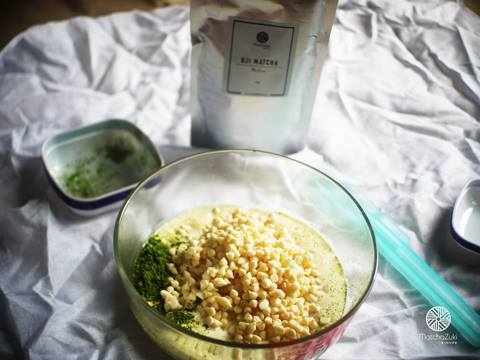
1. Pour whipping cream into a heat-proof bowl and microwave on high for about 30 seconds or until the whipping cream boils slightly. Remove from heat and add white chocolate and green tea powder. Stir until melted.
2. If the mixture is not completely melted, microwave for 15 seconds at a time or until the mixture is fully melted. Let it cool. When cool, refrigerate for at least 3 hours.
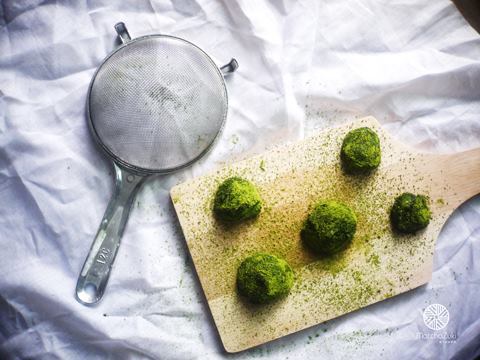
3. When the mixture is cool and firm enough to be molded, take it out and mold it into balls (the truffles will not be very round, don’t worry about it) and mix with the green tea powder again.
Arrange them on a beautiful plate and eat them with hot tea. They go together very well. However, truffles are a dessert that should be eaten while they are still cold. If you are not going to eat them, do not mix them with green tea powder because the moisture in the dessert may make the green tea powder look unappetizing. I recommend mixing them with green tea powder when you are going to eat them. It will look more appetizing. See you next time ^^
———————————-
Matcha Cheese Tart Matcha Cheese Tart
Hello everyone, back to our regular Friday meeting. Today, the MATCHAZUKI page, premium grade matcha powder from Japan, would like to recommend another popular dessert recipe that cheese lovers shouldn’t miss. That is Matcha Cheese Tart, which is sweet, creamy, and full of cheese flavor and intense green tea flavor. Eat it while it’s hot, it feels like eating cheese lava, or eat it in the evening, it has a chewy texture like cheesecake. Let’s take a look at the ingredients and how to make it. ^^
Key Ingredients
Tart section
1. 100 grams of all-purpose flour
2. Butter 60 grams
3. Icing sugar 25 grams
4. Salt 4 grams
5. Half an egg (Beat the egg and use only half)
6. Baking tray as desired and rolling pin
Matcha Cheese Custard Part
1. Cream cheese 150 grams
2. Mascarpone cheese 70 grams
3. 30 grams of butter
4. Fresh milk 90 grams
5. 30 grams of icing sugar (you can add more if you like it sweeter)
6. Cornstarch 10 grams
7. 1 ½ tablespoons of medium grade Matchazuki matcha powder
8. 1 chicken egg
9. ½ tablespoon lemon juice
10. 1 teaspoon of salt
Procedure
Tart section
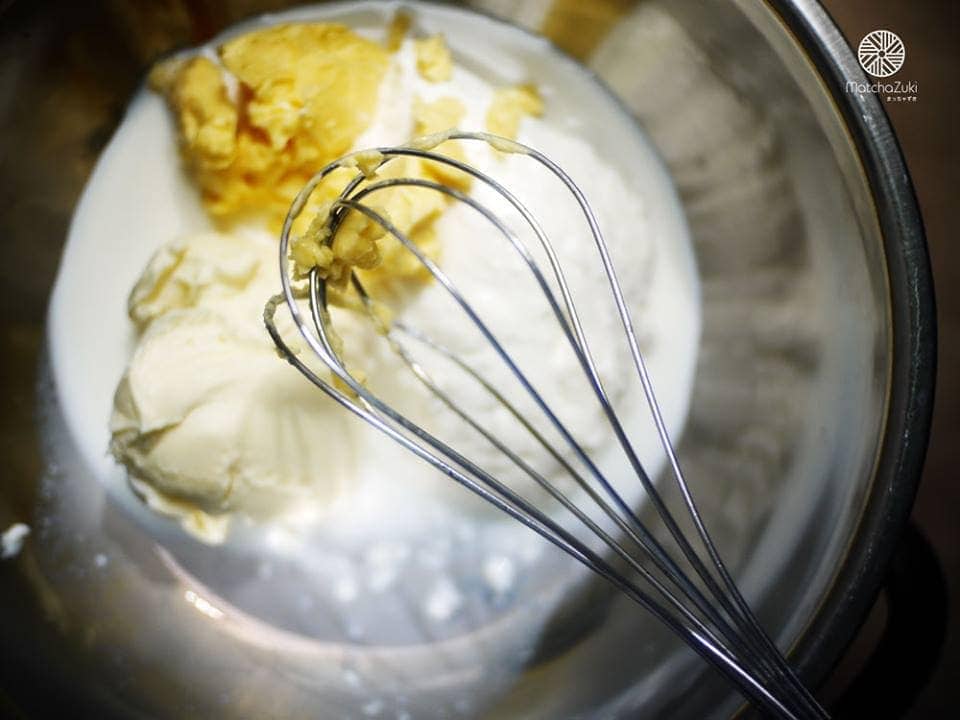
1. Sift flour into a mixing bowl, then add slightly softened butter and mix until well combined. Add icing sugar and salt, then add egg and knead until well combined. Wrap with plastic wrap and refrigerate until butter sets, about 2 hours.
2. Preheat oven to 180 degrees Celsius. Remove dough from refrigerator, roll dough to about 3 mm thick and line mold as desired. Poke small holes in mold with fork. Bake in oven for about 15-20 minutes or until tart is golden brown.
Matcha Cheese Custard Part
1. Place the cream cheese, mascarpone cheese, butter, and half of the milk in a heatproof container (such as a small saucepan or stainless steel bowl). Stir to combine. Bring a larger saucepan of water to a boil over medium heat. Place the container of cheese over the saucepan (double boiler technique) and stir until the mixture is hot and starts to liquefy.
2. Add icing sugar, matcha powder, cornstarch to the remaining milk, mix well and pour into the first mixture. Mix well.
3. Add beaten eggs, salt and lemon juice. Stir constantly to prevent lumps. Stir until mixture thickens and no longer runs from spatula. Cool. Transfer to a piping bag.
4. Squeeze the mixture into the prepared tart shells. Bake at 180 degrees for 10 minutes (if the mold is large, it takes longer) or until the custard surface is firm and dry and does not stick to the fingers.
Matcha Cheese Tart is a dessert that can be eaten both hot and cold. If eaten hot, the custard will be oozing and flowing like lava. But if you put it in the refrigerator, the texture will be as thick as eating cheesecake. It gives a different feeling. Whoever likes which one, choose it as you like. And don’t forget to tell me which one you like more ^^
———————————-
Matcha Strawberry Daifuku, Matcha Daifuku with Red Beans
Matcha Strawberry Daifuku
It’s a beautiful scenery.
Super juicy green tea daifuku with red beans. Once you try it, you’ll fall in love with it^^
Sweet and sour, well-rounded, perfect for this recipe… Just use MATCHAZUKI Medium, real matcha that gives a fragrant, rich aroma, smooth and fine texture. Easy to make for any menu. Let’s go see the recipe.
Key Ingredients
Part 1
- 400 grams of red bean paste
- Strawberries (small) 15 pieces
Part 2
- 25 grams of tapioca flour
- 200 grams of glutinous rice flour
- 70 grams of sugar
- MATCHAZUKI Medium Grade Matcha Powder 6 grams (~3 teaspoons)
- Plain water 330 ml
- 1 cup tapioca flour for sprinkling when kneading the dough
Procedure
- Place a piece of plastic wrap on a cup slightly larger than the strawberries. Press the plastic wrap into the shape of a cup with your hands.
- Put red beans and strawberries in a bowl.
.
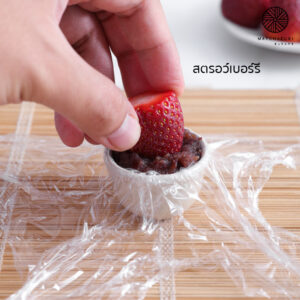 .
. - Wrap the plastic wrap together and shape the red bean and strawberry fillings into balls. Once you have the desired shape, remove from the plastic wrap and place in a container. Refrigerate for 30 minutes.
.
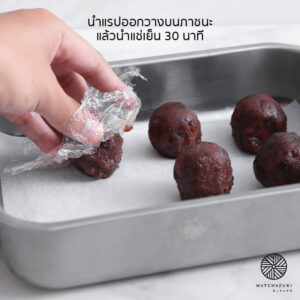 .
. - Mix tapioca flour, glutinous rice flour, matcha powder and sugar in a mixing bowl.
- Gradually add water and stir until the ingredients are completely dissolved.
.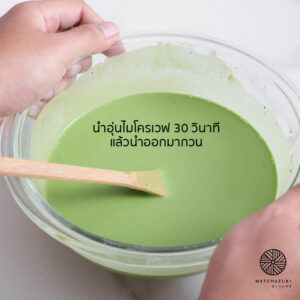 .
. - Microwave for 30 seconds and stir.
- Then heat it for another 6-8 times, 30 seconds each time, until the dough starts to stick.
- Sprinkle flour on the kneading surface and cut the dough into small pieces.
- Use your hands to knead the dough into a sheet, then use a rolling pin to make it a thin sheet.
- Place the prepared red bean filling on the dough sheet.
- Wrap the dough together, press the dough to cover the red bean filling tightly, then cut off the excess dough. Then, tuck the ends neatly.
- Refrigerate for 1 hour and the matcha red bean daifuku is ready to serve 😀
.
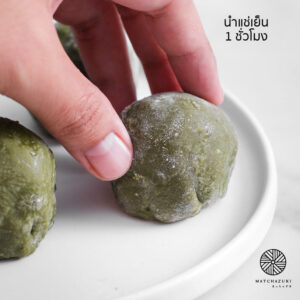 .
.
.
***See more detailed steps on how to make strawberry matcha daifuku in the video below.
.
———————————-
Matcha Chocolate-Dipped Strawberries
Hello, after posting the “Matcha Chocolate-Dipped Strawberries” menu a few days ago, many friends were interested. Today, I would like to share a recipe for a cute menu that anyone can make. This menu is called Matcha Chocolate Dipped Strawberries in Thai. It is an easy dessert that I would like to recommend. Let’s see the ingredients and how to make it. ^^
Key Ingredients
- 8-10 strawberries (freeze for at least 3 hours)
- White chocolate 200 grams
- 1 tablespoon MATCHAZUKI medium grade matcha powder (for mixing with white chocolate)
- 1 tablespoon MATCHAZUKI medium grade matcha powder (for sprinkling on top of desserts)
- 5 grams of butter
Procedure
- Place white chocolate in a microwavable bowl and heat for 30 seconds. When you remove it, you will notice that some of the chocolate has melted. Stir to distribute heat evenly, then microwave for another 30 seconds. Remove and stir again.

- Add butter to the melted white chocolate and mix until well blended. Once the butter has melted into the chocolate, add the green tea powder and mix again.


- Remove the stem from the frozen strawberries and insert a skewer into the stalk instead, but not too deep. Dip the strawberries in the matcha chocolate. (Note: Freezing the strawberries will make them easier to dip and the matcha chocolate will harden faster.)

- When the chocolate starts to harden, add the prepared green tea powder to a sieve and sift it to coat the strawberries that we have dipped in again to increase the intensity of the green tea flavor and make it look more beautiful and delicious.

- Arrange on a beautiful plate. You can sprinkle matcha powder on the plate to make it look more beautiful and appetizing. If you want to cut the strawberries to show their beauty, we recommend that you dip the knife in hot water and wipe it dry before cutting. The matcha chocolate will not break. Or if you are going to give it as a gift, we recommend that after putting it in a box and tying it with a beautiful bow, put dry ice in a small box again because the chocolate should be in a cool place where it will be harder to melt.

———————————-
Green Tea Matcha Chiffon Cake
How to make Green Tea Matcha Chiffon Cake^^
This recipe is from Khun Jumjee in Pantip. The ingredients and method are mostly the same as the original. The only change is the matcha green tea powder and a little bit of matcha green tea powder is added to the cream. ^^
Key Ingredients (for a 2-pound cake)
Cake batter
1. 40 grams of cake flour
2. 50 grams of fine baking sugar
3. Matcha green tea powder (medium grade) 2 teaspoons
5. 1/4 teaspoon salt
4. 1/2 teaspoon vanilla powder
6. Egg yolks (size 2), 2 eggs
7. Vegetable oil (in the recipe, soybean oil is used) 30 grams
8. 50 grams of fresh milk
9. 2 egg whites
10. 30 grams of powdered sugar
11. A little bit of lemon juice
Cream part
1. Whipping cream 250 grams
2. 50 grams of fine baking sugar
3. MATCHAZUKI Excellent grade matcha powder 1.5 teaspoons
Procedure
1. Put flour in a bowl, followed by sugar , matcha green tea powder, vanilla powder, and finally salt.
2. Use a hand whisk to mix all ingredients until they are well blended and do not clump together. Set aside.
3. Next, make the egg yolk part. Start by cracking cold eggs into a cup or bowl (eggs are very important for chiffon cake, so they should be fresh). Separate the egg yolks from the whites, then put the egg whites in a mixing bowl and set aside.
4. Add the egg yolk cup, add oil and then add fresh milk. Set aside.
5. For the last part, which is the egg white part, prepare these 3 things: egg white, lemon juice, and powdered sugar. Separate them first. But you have to prepare them because you have to make them quickly and bake them quickly, or else the eggs will collapse.
6. Preheat oven to 180 degrees Celsius.
7. When everything is ready, start by beating the egg whites on high speed until they are foamy.
8. Squeeze some lemon juice.
9. Then gradually add in the powdered sugar. Do not add it all at once, as this may cause the egg bubbles to collapse.
10. Beat until it forms peaks as shown in the picture.
11. Make the egg yolk mixture. Pour the egg yolk mixture into the flour mixture. Some people may make a well in the center, which will help.
12. Stir quickly, vigorously, and just right. This is the phrase you need to memorize when stirring the egg yolk mixture (the cake will come out soft and melt in your mouth or tough and rough depending on the amount of stirring). Stir until just combined. If you don’t see any white flour, stop immediately.
13. Put the egg whites on top. Actually, according to the theory, you have to pour the flour and egg yolk mixture on top because the egg yolk flour mixture is heavier than the egg white mixture. If we put it on the bottom like this, it will make it difficult to mix together. But that doesn’t mean there’s no way around it. After putting it in like this, flip the egg yolk flour mixture over and pour it on top of the egg white mixture. It will be much easier to mix.
14. Use a rubber spatula to mix the ingredients together. [*Folding means to scrape the rubber spatula along the surface of the mixing bowl to lift the ingredients that are stuck to the edges of the bowl (which are usually heavy ingredients, such as egg yolk flour, etc.) up, not sticking to the edges of the bowl, which will make it difficult to mix. When the heavy ingredients have lifted up to prevent them from sticking back to the edges of the bowl, we flip the rubber spatula to place the heavy ingredients in the center. Now it’s easy to mix, which is called folding.]
15. When mixed together, stop mixing. Observe that the color of the mixture has no streaks. A dark color (in this case, green) means it is mixed. Tap the mold first by doing the following: hold the mold higher than the table surface and let the mold fall freely. Do it about two times to get rid of air bubbles in the cake. Don’t be afraid of it collapsing. Then pour it into the mold and put it in the oven.
16. Bake for about 30 minutes. (**Note: The cake must be cooked. Check for doneness by touching the surface of the cake with your finger. If it sinks and you see a mark when you remove your finger, it is not done yet. Bake for another 3-5 minutes and touch it again. If you start to see no sign of sinking, it is done. Remove it from the oven and use the same technique as before baking: let it fall freely. If it is done, it will not sink, I guarantee it.)
17. Let it cool in the mold or you can scoop it out. It’s not against the rules. Another technique is to turn it upside down on a wire rack. I’ve shared this with my friends, brothers, and sisters here. It’s a good technique because it prevents the cake from collapsing and the texture of the cake is light.
18. Then slice the cake.
19. Now let’s make the cream. This recipe is smooth and not too sweet. If you add more sugar, the aroma of the whipped cream will be greatly reduced. Believe it or not, put the whipping cream in the freezer. But don’t put it in for too long because there is a high risk that the whipped cream will separate. Actually, it is not recommended for beginners because it is easy to make a mistake. But if you have done it before, you can freeze it for 10-15 minutes and it is still usable and easy to whip.
20. When done, beat at high speed and gradually add in powdered sugar. Actually, beat until it starts to form a whisk mark on the whipped cream, then add it right away or add a little bit first. But don’t add it too late because the sugar will not dissolve.
21. When the peaks are stiff, it’s ready. Don’t make it too runny because it will run. It’s okay if it’s a little stiff because the cake is already light. But don’t beat it too much until the whipped cream separates. When you can see the whisk’s tip clearly, you can stop. Be careful with this.
22. Once it’s done, you can put the cream in the refrigerator first because it might be hot. You can freeze it for about 10 minutes, then start decorating it. Spread the cream until it’s as thick as in the picture. Stick the top piece.
23. Spread the cream all over the cake.
24. The final step is to sprinkle green tea powder onto the surface by sifting it through a sieve.
That’s it. Have fun doing it ^.^
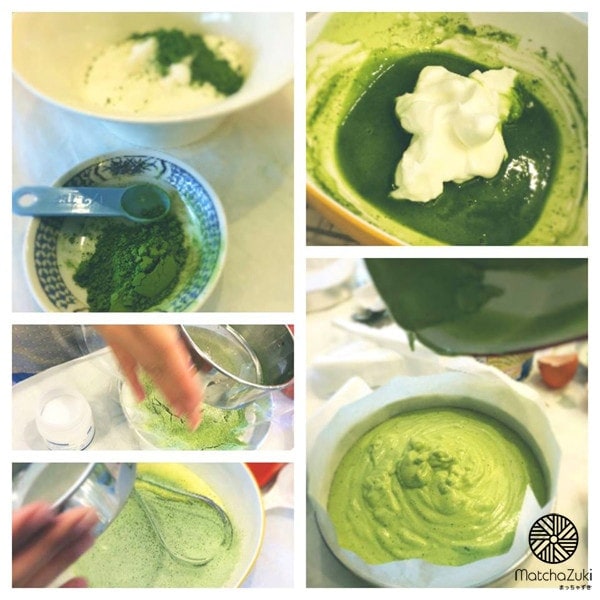
Credit : http://topicstock.pantip.com/food/topicstock/2008/01/D6272478/D6272478.html
———————————-

